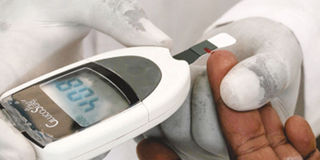Diabetes kills one every seven seconds, beware

What you need to know:
- Diabetes is responsible for one death every seven seconds and accounts for more than 4.6 million deaths per year
- The leading cause of blindness in the world is diabetes
- Damage to the blood vessels can increase the risk of suffering a stroke and heart attack
November is diabetes awareness month and the International Diabetes Federation leads a global campaign of awareness, education and prevention through the World Diabetes Day (WDD), which is celebrated by over 200 member associations and is active in more than 160 countries.
This year’s Diabetes Day, scheduled for Wednesday, will help save and improve the lives of millions of people by offering comprehensive educational campaigns that seek to educate the public of what diabetes is, the risk factors and specific lifestyle recommendations that are needed to curb the destructive condition.
The global burden is yours: A staggering 50 per cent of diabetics do not know that they are. The nearly silent disease is a leading cause of heart disease, stroke, kidney failure, blindness and amputation.
Diabetes is responsible for one death every seven seconds and accounts for more than 4.6 million deaths per year.
The rate of developing diabetes has increased by 700 per cent in the last five decades and can be traced to personal habits.
A proactive lifestyle that includes a healthy diet, regular physical exercise, avoidance of tobacco and maintaining a normal body weight can prevent, delay and even treat the effects of the most common causes of diabetes.
Type 2 diabetes pandemic: Type 2 diabetes accounts for at least 90 per cent of all cases of diabetes. It has also been called non-insulin dependent diabetes or adult-onset diabetes.
The last term is, however, rarely used as many children and teenagers are now developing this once adult condition.
Unknowing victims are commonly diagnosed incidentally through blood or urine tests associated with other active health conditions.
The diagnosis is commonly associated with obesity, insufficient physical activity, smoking and poor diet.
Early symptoms of type 2 diabetes may include:
- Bladder, kidney or other infections that are more frequent or heal slowly
- Fatigue
- Hunger
- Increased thirst
- Increased urination
The first symptom may also be:
- Blurred vision
- Erectile dysfunction
- Pain or numbness in the feet or hands
Complications of type 2 diabetes: Type 2 diabetes is a chronic, life-long condition that requires careful monitoring and control.
Without proper management a person can suffer from very high blood sugar levels that can result in long-term damage to various organs, nerves and tissues.
If one’s type 2 diabetes isn’t well controlled, there are a number of serious or life-threatening complications that one can experience, including blindness, kidney damage, poor circulation and nerve damage.
Diabetes causes blindness: The leading cause of blindness in the world is diabetes.
People with type 2 diabetes may already have abnormalities in the eyes related to the development of the disease. It is important to control not only blood sugar but also blood pressure and cholesterol to prevent its progression.
Poor blood circulation and nerve damage: Damage to the blood vessels can increase the risk of suffering a stroke and heart attack.
Neuropathy and hardening of the arteries can lead to decreased sensation and poor blood circulation in the feet and hands.
This will increase the risk of infections and ulcers that can in turn significantly raise the risk of amputation.
Dr Cory Couillard is an international healthcare speaker and columnist for numerous newspapers, magazines, websites and publications. He works in collaboration with the International Diabetes Federation and the World Health Organization’s goals of promoting diabetes care, prevention and a cure worldwide.
Visit www.idf.org/worlddiabetesday for additional information, to get involved or to see if there are events near you. Visit http://www.idf.org/diabetesatlas/ for 2012 statistics.




